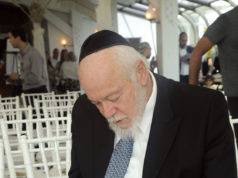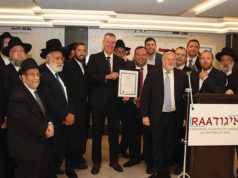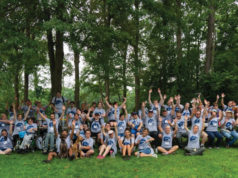 During a recent visit to Mexico, I spent three days in Mexico City, where I had a chance to visit the institutions of the Aleppan Jewish community. My host was Dr. Liz Hamui, a professor at the National University of Mexico, whom I met at the International Conference on Syrian Jewry held in May at Bar Ilan University.
During a recent visit to Mexico, I spent three days in Mexico City, where I had a chance to visit the institutions of the Aleppan Jewish community. My host was Dr. Liz Hamui, a professor at the National University of Mexico, whom I met at the International Conference on Syrian Jewry held in May at Bar Ilan University.
Dr. Hamui is of Aleppan descent and her research has focused on the evolution of the Aleppan Jewish community of Mexico City over the past century. Since I am the self-appointed historian of the Brooklyn Syrian Jewish community, we hit it off immediately and spent our time comparing notes. We found that the two communities have evolved along amazingly similar parallels.
The Mexican Jewish community began in the early 20th century, when both Aleppan and Damascene Jews arrived, after leaving Syria. Many of these Jews went to Mexico City and Buenos Aires after being rejected on Ellis Island.
There are an estimated 40,000 to 50,000 Jews in all of Mexico, with the majority living in Mexico City. Smaller communities live in Guadalajara, Monterey and Cancun. There are four established Jewish communities in Mexico Citythe Aleppans, the Shammies (Jews from Damascus), Sephardic (Turks, Greeks, etc.) and Ashkenazic Jews. Each community is separate and distinct with its own chief rabbi, yeshivahs, community centers, synagogues and minhagim (a custom that is so firmly established as to have almost the binding force of law).
Unlike here in New York, where in the beginning we were the Syrian communitya mixture of Damascene and Aleppan Jewsunder the leadership of a shared Rabbinical Council, the Aleppans and Damascenes are completely separate communities in Mexico City. In cases where there is intermarriage between the communities, the minhag of the husband takes precedence. Thus if the husband is Shammie and the wife is Aleppan, they become members of the Shammie community.
The Brooklyn Syrian community’s first Chief Rabbi was Rabbi Jacob S. Kassin, who came in 1933 to America; his older brother, Rabbi Avraham Kassin, settled in Mexico City in 1931, and became their first Chief Rabbi.
During my time in Mexico City, I visited the Aleppan Yeshiva Keter Tora, operated by David Kassin, son of Rabbi Avraham Kassin, and the sixth of his 10 children. I had time to present the family tree of the Kassin family to Mr. Kassin. In addition, I was presented with Los Judios de Aleppo in Mexico by Dr. Hamui, which contains a history of the community and the family trees of the original families that arrived on the shores at Veracruz, the Mexican entry point for
immigrants.
I was also invited into the home of the Maccos Abadi and Mery Lobaton family, which is the same as the Labaton family here in New York. The Mexican branch of this family is amazing. I spent a siesta afternoon with them, as parents, children and grandchildren came together. Not only did I share my research on the Labaton family tree, but we also compared recipes and I was able to understand the Mexican influence on their recipes.
 The first synagogue of the community was Rofe Zedek and was built in the Colonia Roma area in 1932, the year after Rabbi Avraham Kassin arrived there. In 1965, the community built Maguen David Synagogue in the Polanco area. These buildings correspond with the Brooklyn CommunityMagen David Congregation was built in the 1920s in Bensonhurst and Shaare Zion was opened about 1960. Similarly, Rofe Zedek, like Magen David in Bensonhurst, is used for funeral services.
The first synagogue of the community was Rofe Zedek and was built in the Colonia Roma area in 1932, the year after Rabbi Avraham Kassin arrived there. In 1965, the community built Maguen David Synagogue in the Polanco area. These buildings correspond with the Brooklyn CommunityMagen David Congregation was built in the 1920s in Bensonhurst and Shaare Zion was opened about 1960. Similarly, Rofe Zedek, like Magen David in Bensonhurst, is used for funeral services.
The president of the Maguen David in Mexico City was Isaac Hamui Mussali, the father of Dr. Liz Hamui. Rabbi Sadegh Harari was the Chief Rabbi at the time. The synagogue building has two Bet Midrashes (study halls), a social hall, library and other rooms for study. It is built in a modern style and is decorated with amazing art. The building has a magnificent Star of David at the entrance, from the artist Matias Goeritz. The Torah Ark was renovated in 1985 by artist Enrique Schor. Virtually all community weddings were held in the Maguen David Synagogue until 2003, when another large synagogue opened in the newly-built Maguen David Community Center. Today the Aleppan community has about 50 synagogues and places of worship.
The community’s yeshivah system also evolved on the same path as ours in Brooklyn. Until about 1950, all of the Aleppan Jewish children in Mexico City received a kittab (a small community school which a boy attends until bar mitzvah age) education from a Talmud Torah in the Colonia Roma area or an after school program. From the 1950s to the 1970s, when the community had moved to Polanco, the system changed in that children received a public education provided by the Mexican government, and in the afternoon, received a more concentrated Jewish education.
In the 1960s, Rabbi Abraham Shabot founded the Keter Tora Yeshiva. It originally opened for grades 7-12, but today operates a full day school. In the 1970s Ateret Yosef opened under the supervision of Rabbi David Shweky.
In its first 50 years, the Aleppan community of Mexico had no professional class, much like here in Brooklyn, so the teachers in the yeshivahs came from the Ashkenazic frum community, which influenced the community and provided a haredi (any of several sects of Orthodox Judaism that reject modern secular culture and many of whom do not recognize the spiritual authority of the modern state of Israel) influence that decreased Judeo Arabic culture in both communities. The Mexican community sent its young men to the Lubavitch rabbinical seminary where they had to learn Yiddish to receive their smichas (rabbinical ordination).
It wasn’t until the 1970s that the Aleppan community of Mexico City had its first real day schoolColegio Hebrao Maguen David, with a better academic program. In the 1990s, Atid opened. Today Atid is the Jewish day school of choice for the Aleppan community as its academic education is of high quality. Students not only receive a Jewish education in Hebrew, but they must also learn English.
Today the Aleppan community’s Chief Rabbi is Shlomo Tawil. The Chief Rabbi of the Damascus community is Abraham Teubal of Argentina. Rabbi Teubal succeeded Rabbi Salvadore Hilu (of Aleppan descent), who attended the Lubavitch yeshivah in New York. Their school, Colegio Mount Sinai, was founded in 1943.
The Aleppan community has a burial society, a Bikur Holim and numerous social services, including Kadima, an adult program for people with special needs to teach them skills that will help them earn a living.
The Centro Maguen David, the Aleppan community center, was probably the highlight for me. Built on 25 acres, the facility opened in 2003 and has a synagogue, social hall, the Atid school, classes for children, a computer center operated by ORT Mexico, a gymnasium and many year-round activities for people of all ages. Designed by architect Elias Fasja Lobaton, the facility was built under the supervision of Isaac Hamui during his term as president of the community. The Maguen David Synagogue was built during Hamui’s first term as the community’s president.
Directors of the Centro Maguen David include Joe Sitt Cherem, Nocolas Esses Harari, Marcus Shabot Lobaton, Joe Shakalo Tawil, Johnny Sutton Tawil, Nicolas Sasson Asse, Jacobo Cattan Harari, David Cherem Bettech, Jose Ashkenazi Harari, Alberto Tuachi Ezban and David Hanon Rudy.
The community center features magnificent art work. A full wall features the El Mar Rojo, a mural showing the splitting of the Red Sea by artist Brian Nissen. In the community center synagogue, a magnificent Torah Ark is surrounding on either side by six stained glass windows, each representing one of the 12 tribes of Israel.
The Aleppan community in Mexico City informally used the Takana against marriage to converts issued by Brooklyn’s Syrian Jewish Rabbinical Council in 1935. In 1986, the Mexican community issued its own Takana. Their Takana is unpublished, due to concerns about anti-Semitism. And there are some major differences between the two Takanas, most noticeably the req
uirement that in each application for membership in the community, marriage, a bar mitzvah or life cycle event, the community requires that the applicant prove that they are Jewish going back four generations on both sides of their family. Adoption conversion is only accepted if the child has an Orthodox conversion prior to age two. The only copy of the Takana of the Aleppan Community of Mexico City is held by Habib Achar, the president of the community, who allowed me to see it. He and Dr Hamui translated it into English while I wrote it down.
I was delighted to find so many similarities in the evolution of the Aleppan community in Mexico City and the Syrian community in Brooklyn, including its synagogues, yeshivah system, Takana and community center. I was also fascinated with the differences. I thank the leaders of the community for their generous
hospitality.
_________________________
Sarina Roffe is a community member. She holds a BA in Journalism from the University of Maryland and an MA in Jewish Studies from Touro College. She is a long time contributor to IMAGE Magazine.



